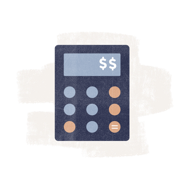As a business owner, you may have heard the term ACH before. You might accept ACH transfers as a payment method from customers. For those of you who aren’t familiar with this banking term, ACH stands for automated clearing house. It’s a method of moving money from one bank account to another without using paper checks.
If your company needs to borrow money but it can’t qualify for a traditional business loan, you may decide to consider alternative financing options. Even if your business has credit challenges, an ACH loan might represent a way to access funds until you can build better business credit scores in the future.
But ACH loans aren’t without their drawbacks. They can be a risky, expensive way to borrow money. Below we highlight how ACH loans work, the benefits you can expect, and some drawbacks to be aware of before you apply.
What Is an ACH Loan?
An ACH loan, sometimes called a cash flow loan or ACH advance, is a type of short-term business financing. When you apply for an ACH loan, the lender usually considers your company’s average daily checking account balance, not your business credit. If you qualify, the lender will withdraw loan payments straight from your business bank account.
ACH Loan Benefits
Does your company need short-term working capital, but can’t qualify to borrow funds from a traditional financial institution? If so, an ACH loan may have some benefits to offer.
- Easier Qualification Criteria: ACH loans are easier to qualify for compared with other business financing options. Because the lender has direct access to your bank account for electronic payments, its risk is lower. As a result, even if your company has less-than-perfect credit history or a low credit score, an ACH lender might be willing to give you a loan if your business bank account has a healthy cash flow.
- Fast Funding: ACH loans are also known for their speed of funding. Like merchant cash advances, you might receive the funds within a few short days after your application is approved. Funds are typically transferred to your account via direct deposit, so you don’t have to wait for paper checks.
- No Collateral: In general, ACH lenders don’t require a borrower to put up collateral to secure the loan.
ACH Loan Drawbacks
You can’t talk about the benefits of ACH loans without also acknowledging that this type of financing has some serious drawbacks.
- An Expensive Way to Borrow: The APR on cash flow loans may climb above 200% (though rates vary widely, depending on the lender). On top of potentially high interest rates, you may be faced with origination fees, prepayment penalties, and other costs.
- Lower Loan Amounts: Depending on the lender, you may be offered lower loan amounts on cash flow loans compared with other business financing options.
- Cash Flow Challenges: Because you give ACH authorization to the lender, it can reach directly into your business bank account to process electronic payments. Budgeting for automatic payment withdrawals or saving money can be difficult as long as the lender has direct access to your business checking or savings account.
- No Business Credit: Many ACH lenders don’t report to the business credit bureaus. If a lender doesn’t report your account to a business credit bureau, your good payment history won’t do anything to help you establish credit.
ACH Loan Repayment Terms
When you take out an ACH loan for your business, it’s meant to be a short-term form of financing. Your lender will withdraw funds directly from your business bank account when your ACH payments are due.
Depending upon the terms of your loan, the recurring payments could take place on a monthly, weekly, or even daily basis. In general, you should expect a fixed amount to be withdrawn for each automatic payment. Be sure to confirm all payment details with your lender.
How to Apply for an ACH Business Loan
If you think an ACH loan is right for your business despite the cost, it’s wise to shop around for financing options with multiple lenders. Compare the total cost of financing, including interest rates and fees.
It’s worth pointing out that ACH lenders may charge fees differently. To avoid confusion, it can help to review the cost of borrowing with each lender as an annual percentage rate (APR). A business loan calculator may help make this process easier.
Once you believe you’ve found the best deal, be ready to supply 3-6 months of business bank account statements to the ACH lender. The lender may ask for other documents as well, like a voided check and a copy of your driver’s license.
Finally, look over your loan agreement and ACH authorization form in detail. It’s important to confirm you’re getting the loan (and the terms) you expected so there are no misunderstandings later.
Before You Apply
Before you apply for an ACH business loan, you should complete the following steps.
- Compare borrowing options. It’s wise to see if there are other ways your business might qualify to borrow money. Check out the Nav Marketplace to shop for alternative small business financing options. Even a business credit card might be a more affordable short-term financing solution than an ACH loan.
- Be sure you understand the repayment terms. How often will recurring payments come out of your bank account? Will the amounts of these electronic payments be fixed or can they vary? It’s critical to understand how the payment processing on an ACH loan is structured upfront.
- Take an honest look at your budget. Are you confident that your business can keep up with the repayment schedule on an ACH loan on top of its existing expenses? If the answer is no, you shouldn’t apply for financing.
Nav’s Final Word: ACH Loan
There are many business financing options you can consider when you need to access funding for your company. Even if your business can’t qualify for a loan from a traditional financial institution like a bank or credit union, that doesn’t mean you have to settle for high-cost financing that might hurt your business in the long run.
If you do opt to take out an ACH loan, move forward with extreme caution. Make sure you have a plan to pay off your loan as soon as possible. Ideally, you should work to build better business credit so you can avoid this type of high-cost financing the next time your business needs access to capital.
This article was originally written on February 5, 2020 and updated on June 25, 2020.



Have at it! We'd love to hear from you and encourage a lively discussion among our users. Please help us keep our site clean and protect yourself. Refrain from posting overtly promotional content, and avoid disclosing personal information such as bank account or phone numbers.
Reviews Disclosure: The responses below are not provided or commissioned by the credit card, financing and service companies that appear on this site. Responses have not been reviewed, approved or otherwise endorsed by the credit card, financing and service companies and it is not their responsibility to ensure all posts and/or questions are answered.